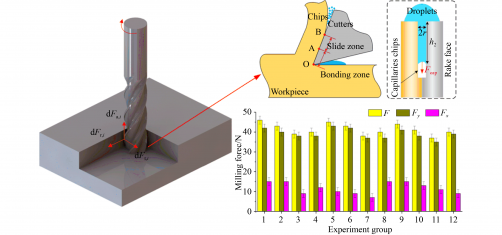
In a significant advancement for aerospace manufacturing, researchers have developed a new milling technology aimed at improving the machining of the nickel-based high-temperature alloy, GH4169. This alloy is crucial for the production of aeroengine components due to its exceptional properties, including high-temperature strength and corrosion resistance. The study, conducted by a team from Qingdao University of Technology and Hanergy Lubrication Technology Co., Ltd., focuses on the challenges associated with machining GH4169, particularly high milling temperatures and residual stress that can occur during processing.
Traditional methods of lubrication in machining, especially high-flow cutting fluids, often lead to environmental concerns and low efficiency in resource utilization. Minimum quantity lubrication (MQL) techniques have emerged as alternatives but come with their own set of drawbacks, such as inconsistent droplet sizes and potential health risks from airborne fine particles. To address these issues, the research introduces Electrostatic Atomization Minimum Quantity Lubrication (EMQL), a promising technique that utilizes electric fields to enhance lubrication effectiveness during milling.
The research team, including authors Min Yang, Hao Ma, Zhonghao Li, and others, established a milling force model by breaking down the helical edge of the end mill into microelements. This model considers various forces acting on the microelements, leading to a comprehensive analysis of the total cutting force. Evaluation experiments utilized soybean oil as the lubrication medium to compare the performance of EMQL against conventional pneumatic atomization MQL.
Results indicated that EMQL significantly outperforms traditional methods, reducing milling force by 15.2% to 15.9%, and improving surface roughness by between 30.9% and 54.2%. Additionally, the average roughness spacing decreased by up to 58.3%, the friction coefficient dropped by 55%, and cutting specific energy saw a reduction of 19.6%. These improvements highlight the potential for EMQL to enhance both efficiency and quality in machining difficult materials.
Optimizing Parameters for Better Performance
The study further explored the impact of various parameters on milling performance through orthogonal optimization experiments. These tests assessed factors such as flow rate, air pressure, voltage, incident angle, elevation angle, and target distance. Findings revealed that air pressure was the most influential factor on milling force and cutting energy, contributing 22% to performance changes. Voltage, on the other hand, played a crucial role in improving surface roughness, accounting for 36.71% of the observed effects.
To maximize performance while minimizing environmental and health impacts, the researchers identified an optimal parameter combination: a flow rate of 80 mL/h, air pressure of 0.1 MPa, voltage of 30 kV, nozzle incident angle of 35°, elevation angle of 30°, and a target distance of 40 mm.
This research marks a pivotal step forward in the machining of aerospace materials, promising enhanced surface integrity and reduced environmental impact during cutting processes. The comprehensive findings are detailed in the paper titled “Force Model in Electrostatic Atomization Minimum Quantity Lubrication Milling GH4169 and Performance Evaluation,” authored by Min Yang and colleagues. For further reading, the full text is available at https://doi.org/10.1007/s11465-024-0800-8.







